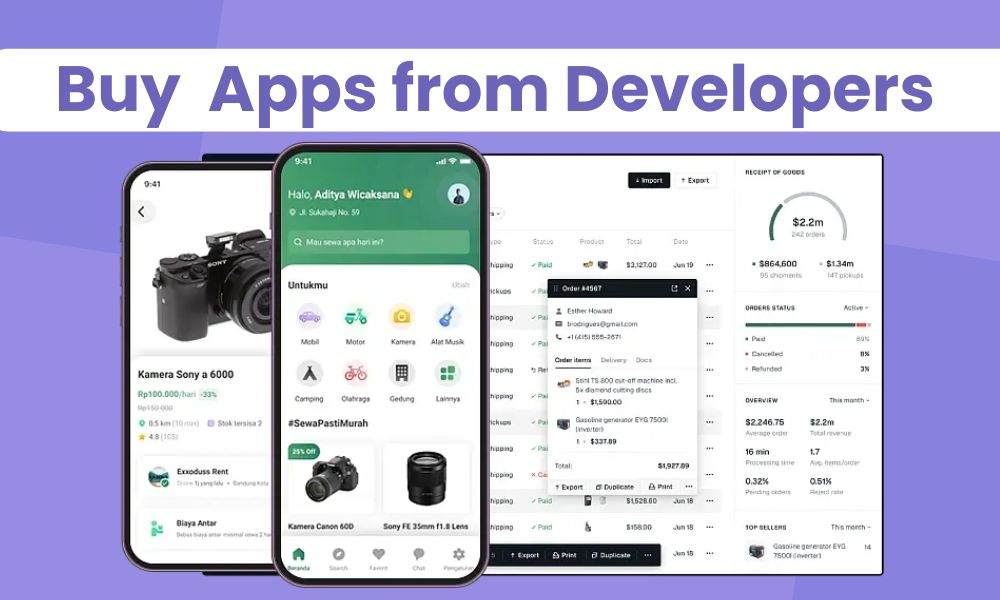For businesses looking to streamline operations, enhance customer engagement, or innovate their product offerings, investing in the right application is crucial. Instead of relying on third-party app marketplaces or pre-built solutions, many organizations are now choosing to buy apps from developers directly. This route not only provides more control over the development process but also ensures that the app is customized to your specific business needs.
Buying apps directly from developers can be an efficient way to secure top-grade apps for every industry, from retail to finance to healthcare. If you're considering this approach, it's important to understand the steps involved, how to evaluate developers, and what you can do to ensure you're getting the best value for your investment. In this guide, we will walk you through the process of acquiring high-quality apps from developers, whether you’re looking for off-the-shelf solutions or customized, on-demand app development.
Step 1: Define Your Business Needs and Objectives
Before diving into the world of app development, it’s essential to clearly define what you want the app to achieve. This first step is crucial because the functionality and features of the app will depend on the specific challenges or goals your business aims to address.
- What problems are you solving? Whether you're improving internal workflows, creating a customer-facing application, or integrating new features into existing software, pinpointing the core problem will help you articulate the type of app you need.
- Who will use the app? Identify the target audience—whether it's employees, customers, or business partners. This will affect the app’s design, usability, and features.
- What platforms do you need the app to run on? Consider if you need an app for iOS, Android, or both. If your business operates across multiple platforms, you may want a cross-platform app.
Taking the time to lay out clear goals will make it much easier to communicate your needs to developers and ensure that you get the app that fits seamlessly into your business model.
Step 2: Search for a Reliable Developer or Development Company
Once you have a clear understanding of your app's requirements, it's time to find the right developer. Choosing a skilled developer or an on-demand app development company is a critical step in ensuring the success of your project. Here’s how to find the right fit:
- Research their portfolio: A reputable developer or development company should have a diverse portfolio of previous apps they've worked on. Look for examples that align with your industry or the type of app you're interested in.
- Check references and reviews: Don’t hesitate to ask for references or read reviews from other businesses that have worked with the developer. Real-world feedback can help you understand their work ethic, communication style, and reliability.
- Assess their technical expertise: Make sure the developer has expertise in the platforms and technologies that you require. Whether it’s mobile development, web applications, or cloud-based solutions, they should have the experience and know-how to execute your project.
- Consider their ability to scale: It's important to choose a developer who can not only deliver the app you need today but also support its growth as your business evolves.
Step 3: Evaluate the Developer’s Approach to Customization
A significant advantage of buying apps directly from developers is the ability to have the app tailored to your specific business requirements. This is particularly beneficial if you're looking for top-grade apps for every industry, as it allows you to customize the app to suit your unique processes, branding, and goals.
When evaluating a developer, ask them about their approach to customization:
- How flexible is the development process? Ensure that the developer is open to adjusting the app to meet your evolving needs.
- Can they integrate with your existing systems? The app should seamlessly integrate with any other tools or platforms your business is already using, whether that’s CRM software, eCommerce platforms, or internal databases.
- Are there options for ongoing support and updates? Apps need to evolve with time. Choose a developer who can provide long-term support and updates, ensuring the app remains relevant and functional.
A well-developed app should enhance your business processes, not just replicate existing solutions. This customization ensures that your app is a true asset that can scale with your organization.
Step 4: Negotiate Terms and Costs
Buying an app directly from developers often comes with more flexibility than purchasing pre-built solutions, but it’s also important to establish clear terms and a solid understanding of costs upfront. Transparent negotiations help to avoid hidden fees and unexpected expenses as the development progresses.
Here are a few factors to keep in mind when negotiating terms:
- Project timeline: Discuss realistic deadlines for each phase of development. Make sure there’s an understanding of what the initial delivery will include and what’s planned for future phases.
- Budget considerations: Development costs can vary significantly depending on complexity, design, and features. Be clear about your budget and ask for a detailed breakdown of the costs, including development, testing, and deployment.
- Ownership and intellectual property: Clarify the ownership rights to the final app, as well as any intellectual property (IP) associated with the app. You should retain full ownership of the app and its code after payment is made.
- Payment milestones: Establish clear payment milestones linked to specific deliverables. This helps ensure the project stays on track and reduces financial risk.
Having a clear, documented agreement in place protects both you and the developer and sets expectations for the project’s scope and deliverables.
Step 5: Review and Test the App Thoroughly
Once the app is developed, it’s time to thoroughly review and test it. While the developer will typically perform a round of testing, you should also carry out your own quality assurance (QA) testing to ensure the app meets your expectations and business needs.
- Usability testing: Ensure that the app is user-friendly and easy to navigate. If your team or customers are going to use the app, make sure it’s intuitive and efficient.
- Functionality testing: Test the app’s core features to make sure everything works as expected. Are all the buttons functioning correctly? Do the features integrate seamlessly with your other tools or platforms?
- Security testing: Ensure that the app adheres to industry-standard security practices. This is especially important if the app collects sensitive data or involves financial transactions.
- Performance testing: Make sure the app performs well under stress. Test its performance on different devices, screen sizes, and network conditions to identify any potential issues before launch.
By conducting thorough testing, you’ll be able to catch any issues early and make adjustments before the app goes live.
Step 6: Launch and Monitor
Once testing is complete and you’re satisfied with the app’s functionality, it’s time to launch! This is the moment when your business can begin reaping the rewards of the customized solution you’ve worked on with your developer.
However, the work doesn’t stop at launch. It's crucial to continue monitoring the app’s performance to ensure it’s meeting your business objectives. Here’s what to focus on post-launch:
- User feedback: Collect feedback from your team, customers, or users to identify any pain points or areas for improvement.
- Usage analytics: Track how the app is being used. Are users engaging with the features you intended them to? Are there areas where engagement is lower than expected?
- Bug fixes and updates: Ensure that your developer is available to address any bugs or glitches that appear post-launch. Regular updates will keep the app running smoothly and securely.
Conclusion
Choosing to buy apps from developers directly gives your business a clear edge by providing a more personalized, scalable, and cost-effective solution. Whether you're looking for top-grade apps for every industry or seeking an on-demand app development company that can cater to your unique needs, working directly with developers ensures that your app is designed to meet your specific requirements, both now and in the future.
By following the steps outlined in this guide—from defining your business needs to launching the app and beyond—you can make informed decisions, secure a high-quality app, and enhance your business's digital presence. The right app can unlock new opportunities, improve efficiency, and set your company up for long-term success. So, take the plunge, partner with the right developer, and create an app that truly works for your business.


